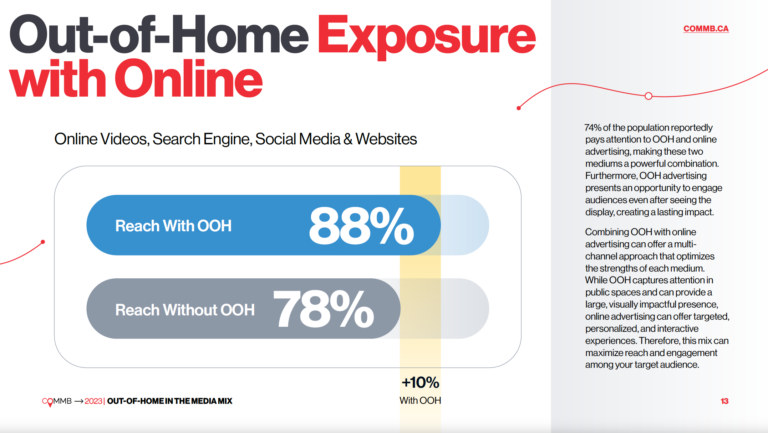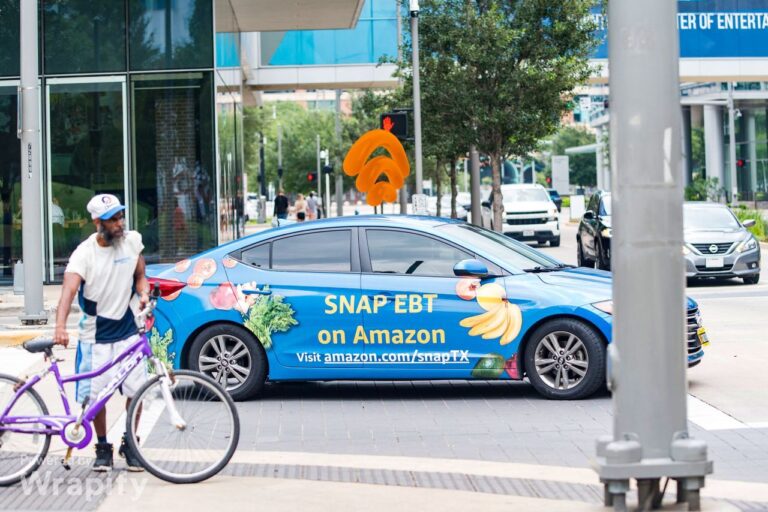Some things just go better together. Like…
PB & J
Batman & Robin
Bacon & Eggs
Bonnie & Clyde
Salt & Pepper
Pam & Jim
Fries & Ketchup
Sonny & Cher
Animal Style & In-N-Out
Online & Offline Advertising

Although we’d love to dive into our love for peanut butter and jelly sandwiches or our favorite Pam & Jim moments from The Office, you know that’s not why we’re here, but we hope it enticed you to continue reading.
We’re here to discuss the benefits of offline and online advertising and how using them in concurrence will provide the biggest ROI for your brand.
Offline advertising and online advertising are two distinct approaches to reaching and engaging with audiences… we can all agree on that, right? While they operate in different realms, they can complement each other effectively when used in a coordinated and strategic manner.

According to a recent report by COMBB, OOH makes your digital 10% more performant. Find out exactly why and how.
10 Reasons To Combine Offline & Online Advertising:

- Brand Recognition and Recall: Offline advertising, such as billboards, rideshare advertising, radio ads, and TV commercials, are used to create strong brand recognition and recall. When people encounter your brand offline, they are more likely to remember it when they come across it online, increasing the likelihood of engagement and conversions.
- Multi-Channel Reach: Combining offline and online advertising enables you to reach a broader audience across different touchpoints. While online advertising targets users who are active on the internet, offline methods can reach those who might not spend as much time online or who may be more receptive to traditional advertising methods.
- Enhanced Trust and Credibility: Offline advertising can contribute to your brand’s credibility and trustworthiness. Seeing your brand featured in newspapers, magazines, or TV can lend a sense of legitimacy, which can positively impact how online audiences perceive your brand.
- Cross-Promotion: Offline advertising can be used to promote online content or offerings. For example, a TV commercial might direct viewers to visit a website or use a specific hashtag on social media. This cross-promotion can drive traffic to your online platforms and increase online engagement.
- Leveraging QR Codes and Short URLs: Offline advertising can incorporate QR codes or short URLs that lead to specific online content. This bridge between offline and online experiences can encourage audiences to take immediate online actions, such as visiting a website, signing up, or making a purchase.
- Engagement Amplification: Offline events or promotions, such as trade shows, seminars, or product launches, can be promoted online beforehand and afterward. Online platforms can be used to generate buzz, share event highlights, and extend the engagement beyond the physical event.
- Targeted Advertising: Offline advertising can help raise awareness among a broader audience, while online advertising can target specific segments with greater precision. By combining the two, you can create a comprehensive marketing strategy that caters to both broad and niche audiences.
- Data Visualization and Analysis: Online advertising generates a wealth of data that can be used to refine offline campaigns. Insights from online user behavior, such as click-through rates and demographics, can inform the design and messaging of offline materials to better resonate with the intended audience. And vice versa with such campaigns as Wrapify, you can use data we collect from impressions within your geotargetted campaign along the data from mobile ad ids to better understand your target audience and make better decisions for future campaigns whether offline or online.
- Consistency in Messaging: Coordinating offline and online advertising ensures consistent branding and messaging across all touchpoints. This consistency helps in building a coherent brand identity and reinforces the message you want to convey.
- Retargeting Opportunities: Users who encounter your brand offline can be targeted with online remarketing efforts. This keeps your brand top-of-mind and encourages users to revisit your website or engage with your online content.
SOOO there ya have it. Integrating offline and online advertising allows you to create a seamless and holistic customer experience. By leveraging the strengths of both approaches, you can effectively reach, engage, and convert your target audience across various platforms and channels. For more information, let’s talk today!
